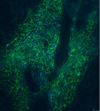The T cell in Sjogren's syndrome: force majeure, not spectateur
- PMID: 22709856
- PMCID: PMC3428488
- DOI: 10.1016/j.jaut.2012.05.019
The T cell in Sjogren's syndrome: force majeure, not spectateur
Abstract
Sjogren's syndrome (SS) is characterized by infiltration of exocrine glands with T and B lymphocytes, leading to glandular dysfunction and frequently accompanied by hypergammaglobulinemia and autoantibodies. The role of T cells, which predominate in the lesions, has attracted much interest. CD4 T cells seem to be responding to autoantigens on apoptotic cells, such as the Ro and La antigens, or to the cytoskeletal antigen α-fodrin. Physical injury to ocular surfaces may also lead to T cell mediated responses to self antigens and perpetuate disease. Within the salivary glands, T cell responsiveness is further promoted by the special capacity of salivary epithelial tissue to provide costimulation and enhanced antigen presentation. Cytokines are key mediators of the T cell contribution to pathology, with roles attributed both to Th1 and Th2 cells. Recently, striking data implicate Th17 cells in the stimulation of B cells, and a role for the related cytokine IL-21 produced by follicular T helper cells is now appreciated. Dysfunction of T regulatory cells has been shown to have a role in the exuberant production of cytokines by Th17 cells. Beyond their role in provoking B cell hyperactivity and immunoglobulin secretion, T cells are directly involved in destruction of glands through Fas and perforin-mediated cytotoxicity. Animal models of SS have confirmed the role of T cell derived cytokines in disease and support a role for effector-memory cells in pathogenesis. Further elucidation of the role of T cells will open avenues for better treatment of SS, whose current management is still mainly supportive.
Copyright © 2012 Elsevier Ltd. All rights reserved.
Figures

References
-
- Youinou P. Sjogren's syndrome: a quintessential B cell-induced autoimmune disease. Joint Bone Spine. 2008;75:1–2. - PubMed
-
- Fox RI, Adamson TC, 3rd, Fong S, Young C, Howell FV. Characterization of the phenotype and function of lymphocytes infiltrating the salivary gland in patients with primary Sjogren syndrome. Diagn Immunol. 1983;1:233–239. - PubMed
-
- Adamson TC, 3rd, Fox RI, Frisman DM, Howell FV. Immunohistologic analysis of lymphoid infiltrates in primary Sjogren's syndrome using monoclonal antibodies. J Immunol. 1983;130:203–208. - PubMed
-
- Christodoulou MI, Kapsogeorgou EK, Moutsopoulos HM. Characteristics of the minor salivary gland infiltrates in Sjogren's syndrome. J Autoimmun. 34:400–407. - PubMed
Publication types
MeSH terms
Substances
Grants and funding
LinkOut - more resources
Full Text Sources
Other Literature Sources
Medical
Research Materials
Miscellaneous

